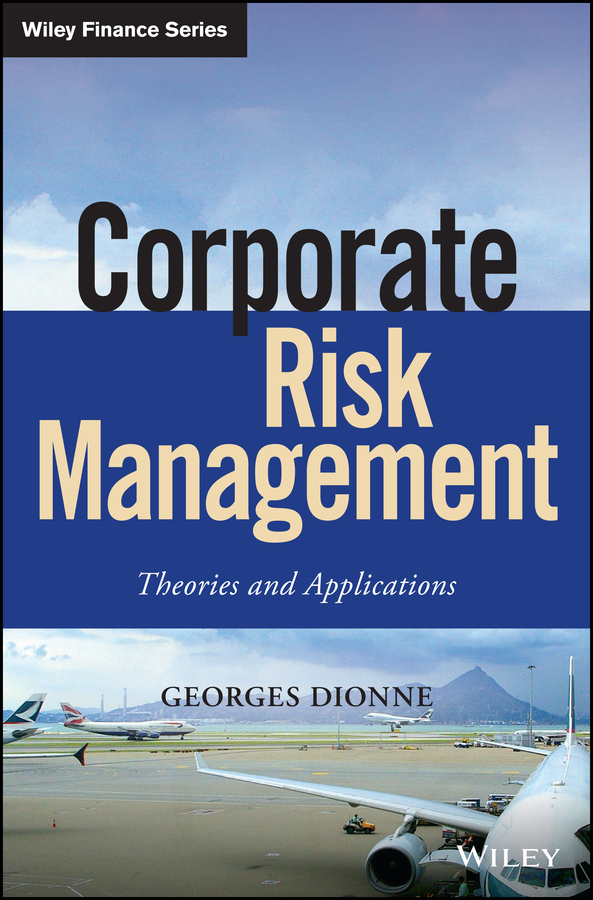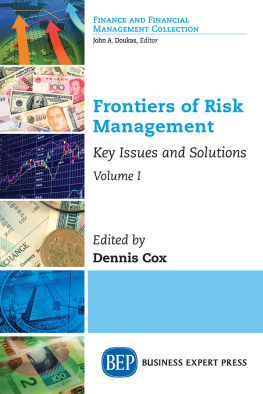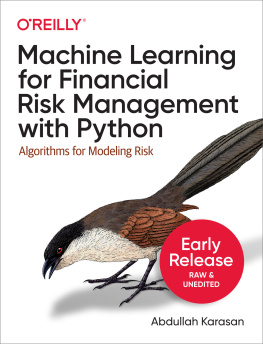Georges Dionne - Corporate Risk Management: Theories and Applications
Here you can read online Georges Dionne - Corporate Risk Management: Theories and Applications full text of the book (entire story) in english for free. Download pdf and epub, get meaning, cover and reviews about this ebook. year: 2019, genre: Business. Description of the work, (preface) as well as reviews are available. Best literature library LitArk.com created for fans of good reading and offers a wide selection of genres:
Romance novel
Science fiction
Adventure
Detective
Science
History
Home and family
Prose
Art
Politics
Computer
Non-fiction
Religion
Business
Children
Humor
Choose a favorite category and find really read worthwhile books. Enjoy immersion in the world of imagination, feel the emotions of the characters or learn something new for yourself, make an fascinating discovery.

- Book:Corporate Risk Management: Theories and Applications
- Author:
- Genre:
- Year:2019
- Rating:5 / 5
- Favourites:Add to favourites
- Your mark:
- 100
- 1
- 2
- 3
- 4
- 5
Corporate Risk Management: Theories and Applications: summary, description and annotation
We offer to read an annotation, description, summary or preface (depends on what the author of the book "Corporate Risk Management: Theories and Applications" wrote himself). If you haven't found the necessary information about the book — write in the comments, we will try to find it.
Corporate Risk Management: Theories and Applications — read online for free the complete book (whole text) full work
Below is the text of the book, divided by pages. System saving the place of the last page read, allows you to conveniently read the book "Corporate Risk Management: Theories and Applications" online for free, without having to search again every time where you left off. Put a bookmark, and you can go to the page where you finished reading at any time.
Font size:
Interval:
Bookmark:

- Chapter 1
- Chapter 4
- Chapter 5
- Chapter 7
- Chapter 8
- Chapter 9
- Chapter 10
- Chapter 11
- Chapter 12
- Chapter 13
- Chapter 14
- Chapter 15
- Chapter 16
- Chapter 18
- Chapter 20
- Chapter 21
- Chapter 2
- Chapter 3
- Chapter 4
- Chapter 5
- Chapter 6
- Chapter 7
- Chapter 8
- Chapter 9
- Chapter 10
- Chapter 11
- Chapter 12
- Chapter 13
- Chapter 14
- Chapter 15
- Chapter 16
- Chapter 20
- Chapter 21
Founded in 1807, John Wiley & Sons is the oldest independent publishing company in the United States. With offices in North America, Europe, Australia and Asia, Wiley is globally committed to developing and marketing print and electronic products and services for our customers' professional and personal knowledge and understanding.
The Wiley Finance series contains books written specifically for finance and investment professionals as well as sophisticated individual investors and their financial advisors. Book topics range from portfolio management to e-commerce, risk management, financial engineering, valuation and financial instrument analysis, as well as much more.
For a list of available titles, visit our website at www.WileyFinance.com.
GEORGES DIONNE

Copyright 2019 by Georges Dionne. All rights reserved.
Published by John Wiley & Sons, Inc., Hoboken, New Jersey.
Published simultaneously in Canada.
No part of this publication may be reproduced, stored in a retrieval system, or transmitted in any form or by any means, electronic, mechanical, photocopying, recording, scanning, or otherwise, except as permitted under Section 107 or 108 of the 1976 United States Copyright Act, without either the prior written permission of the Publisher, or authorization through payment of the appropriate per-copy fee to the Copyright Clearance Center, Inc., 222 Rosewood Drive, Danvers, MA 01923, (978) 750-8400, fax (978) 646-8600, or on the Web at www.copyright.com. Requests to the Publisher for permission should be addressed to the Permissions Department, John Wiley & Sons, Inc., 111 River Street, Hoboken, NJ 07030, (201) 748-6011, fax (201) 748-6008, or online at www.wiley.com/go/permissions.
Limit of Liability/Disclaimer of Warranty: While the publisher and author have used their best efforts in preparing this book, they make no representations or warranties with respect to the accuracy or completeness of the contents of this book and specifically disclaim any implied warranties of merchantability or fitness for a particular purpose. No warranty may be created or extended by sales representatives or written sales materials. The advice and strategies contained herein may not be suitable for your situation. You should consult with a professional where appropriate. Neither the publisher nor author shall be liable for any loss of profit or any other commercial damages, including but not limited to special, incidental, consequential, or other damages.
For general information on our other products and services or for technical support, please contact our Customer Care Department within the United States at (800) 762-2974, outside the United States at (317) 572-3993, or fax (317) 572-4002.
Wiley publishes in a variety of print and electronic formats and by print-on-demand. Some material included with standard print versions of this book may not be included in e-books or in print-on-demand. If this book refers to media such as a CD or DVD that is not included in the version you purchased, you may download this material at http://booksupport.wiley.com. For more information about Wiley products, visit www.wiley.com.
Library of Congress Cataloging-in-Publication Data
Names: Dionne, Georges, author.
Title: Corporate risk management : theories and applications / Georges Dionne.
Description: Hoboken, New Jersey : Wiley, [2019] | Series: The Wiley finance series | Includes index. |
Identifiers: LCCN 2019001984 (print) | LCCN 2019006503 (ebook) | ISBN 9781119583158 (ePub) | ISBN 9781119583172 (ePDF) | ISBN 9781119583127 (Hardcover)
Subjects: LCSH: Risk management.
Classification: LCC HD61 (ebook) | LCC HD61 .D56 2019 (print) | DDC 658.15/5dc23
LC record available at https://lccn.loc.gov/2019001984
Cover Design: Wiley
Cover Image: Danielle Blanchard
To Danielle
Risk management, which is omnipresent nowadays, as Georges Dionne rightly highlights, is nevertheless a relatively young field. Twenty or 30 years ago, the term would have seemed pretentious, and the natural reaction of a company director would have been to associate it with the management of insurance coverage. Not that insurance is no longer the anchor point for risk managementit still isbut the term risk management means a lot more than just insurance coverage. In this respect, three events have changed the content of risk management: the collapse of the Long-Term Capital Management fund in 1998, followed by that of Enron in 2001, and finally that of Lehman Brothers in 2008. These three companies were all among the best in their category, and were considered to have the most sophisticated risk management of the time. Lehman Brothers was thus rated excellent in risk management, a real role model. This made these failures all the more resounding. Three main lessons have been drawn from these incidents. First of all, good management of identified risks presupposes good overall governance of all the processes of the organization concerned. Next, sophistication is not enough for good risk management, because it can mask major deficiencies in terms of internal control. Finally, operational risk should not be underestimated and should be subjected to careful and reasoned assessment.
Risk management therefore goes beyond simple knowledge of the risks to which the company is exposed, their possible aggregate cost, and the techniques used to cover them. It covers governance, internal control, and compliance with regulatory requirements. In concrete terms, it covers complex processes that play out in seven logical steps:
- First of all, a general system of good governance must be in place, which ensures the transparency of management and the rationality of the decisions made by those in charge of the organization.
- Then the governing bodies need to set objectives for the organization concerned, in sufficient detail (what are the missions, and under what conditions they should be completed?).
- Also, from these objectives, the governing bodies need to ascertain the organization's preferences in terms of risk or risk appetite (which risks to take or not take, minimise, etc.), bearing in mind that the objective of risk management is not to exclude risk but to control it.
- After this, the current and emerging risks to which the organization is exposed need to be identified, and their impact on it measured in terms of frequency and severity.
- The next step consists of deciding which measures are necessary to control these risks, by ruling them out, transferring them to other agents, or containing them within predefined limits.
- Next, processes, thresholds, and controls must be implemented to ensure that risk control is in place throughout the organization.
Font size:
Interval:
Bookmark:
Similar books «Corporate Risk Management: Theories and Applications»
Look at similar books to Corporate Risk Management: Theories and Applications. We have selected literature similar in name and meaning in the hope of providing readers with more options to find new, interesting, not yet read works.
Discussion, reviews of the book Corporate Risk Management: Theories and Applications and just readers' own opinions. Leave your comments, write what you think about the work, its meaning or the main characters. Specify what exactly you liked and what you didn't like, and why you think so.







